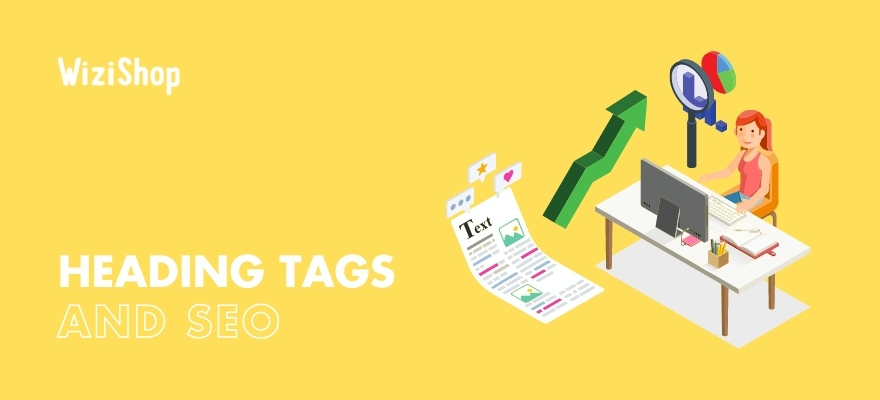Page structure plays a major role in your search engine optimization (SEO) strategy. To correctly tag a piece of content, it’s necessary to master the use of heading tags.
Essential for working on your SEO effectively, headings are beneficial for search engines like Google but also for internet users who find your website in the search results or otherwise!
So, how do you optimize your heading tags for SEO in the best way possible? Here are some tips to help guide you.
What are heading tags?
First of all, let’s start by defining precisely what heading or Hn tags are.
Also called headings, they designate the markers or HTML tags integrated on each of the titles or subtitles of your pages. They’re represented in the code of your page, in this form: <h1>, <h2>, <h3>, <h4>, <h5>, and <h6>.
There are six of these, and they provide a hierarchy to your content. The H1 tag is more important than the H2, which is itself more important than the H3 and so on.
Discover our detailed article on the H1 tag.
With the use of Hn tags, writers are able to classify the information on the page. They build the skeleton of each article to help make the reading of texts clearer and more accessible.
The Hn tags therefore offer better visual identification and text that’s more relevant. They make it possible to browse an article in a more instinctive way, especially visually.
Most of the time, if the CSS code is set correctly, the font of the main titles is larger than that of the subtitles.
Hn tags also have an SEO role. They’re not just used to format the design of the titles in your site’s content.
The hierarchy of Hn tags
To create effective SEO writing, Hn tags must be ordered and hierarchical. By respecting this condition, you’ll facilitate the understanding of your text for readers and Google robots.
Thus, always keep in mind that
- Your H1 title should be the most important.
- H2s are the principal parts of your article.
- The H3s represent the subsections of your H2.
- H4, H5, and H6 are less frequently used tags that can offer additional information about your website’s content.
Logically, all the heading tags must respond to the main theme of your content, mentioned in the H1 tag and in the title tag. Headings should be created with an SEO approach but also for the user experience.
Discover our guide on the title tag.
What are the benefits of Hn tags?
Hn tags offer many advantages, both for the company or the writer who writes the page and for search engines and readers.
They serve as
- A pillar in writing : They act as a map to structure the ideas of the writer. The Hn tags are like titles of parts to be completed with relevant information.
- A guide for search engine robots: Headings help search engine crawlers know what the page is about and reinforce the presence of certain keywords in the text of the website.
- A reading aid: By providing a structure to the text, Hn tags allow readers to scan the content of a site at a glance to go, for example, directly to the part that interests them.
Simply put, Hn tags provide a structure to a block of text. Without them, web users and robots would be confronted with an indigestible wall of words, which is unattractive, very discouraging, and not great for marketing.
Thanks to Hn tags, reading is much more easily facilitated.
Moreover, we should note that this consistency also improves the duration of visits on each page, which can help to improve your SEO. The more ergonomic and logical the pages are, the more the user will enjoy spending time on them and consulting them.
How do you write Hn tags properly?
So, how do you write your Hn tags correctly? Here are the main elements to take into account to best optimize your heading markup.
A limit only for the H1
First and foremost: you only need one H1 tag per page.
After all, you wouldn’t use several main titles for an article or several titles for a book? The best practice is to have only one H1 tag per page.
As for the other tags, on the other hand, the best practice is more vague, and it’s more a matter of logic and common sense in relation to the subject matter than a real requirement.
There’s actually no limit on the quantity.
In this respect, H2 and H3 tags are very useful to structure a page and divide it into several subsections. They’re valuable allies in making a text more readable and easier to understand.
They save readers time and allow them to go to the content that interests them at a glance. Thus, they act as a kind of summary.
In terms of the number of H2s and H3s, it’ll often depend on the size of your text. If you’re presenting a travel guide on the city of Paris, it’s quite possible that your content contains dozens of H2s and H3s. On the other hand, for a product page, the number will be smaller.
The H4, H5, and H6 tags can be useful for specifying and structuring the subsections.
These headings are generally used when the content is long. When there are too many of them in relation to the size of the article, they can become counterproductive and make the reading too choppy. In this case, it’s better to replace them with bulleted lists: the latter offer a rendering that’s more fluid but still hierarchical and coherent.
Optimal size
While the number of Hn tags isn’t limited, the number of characters of these tags isn’t defined either.
From Google’s point of view, you’re therefore totally free to create longer or shorter tags. In practice, however, things are a little different.
Long sentences tend to put off readers, who don’t quite understand why so much information is crammed into a title. When tags are too long, they’re less effective.
Their objective is to catch the user’s eye and make them want to read the part following the tag. If everything is said in the title, there’s no reason to read the rest...
You should also know that although very long titles allow you to use a lot of keywords, they also tend to dilute the most important words. If you don't want to drown your principal keyword under a lot of unnecessary information, you should use short, clear, and precise tags.
They’ll be much more beneficial for your SEO while also being more pleasant for your readers.
Keywords
As you can see, because Hn tags have a certain weight in SEO, you should try to integrate your main keywords.
I strongly advise you to use your main keyword or related keywords in a consistent and natural way in your tags. Similar to the optimization of an ALT attribute for the SEO of an image, you don’t want to overload your heading tags with keywords.
Unique tags
Each page of your site must contain unique Hn tags. It’s best to avoid repetition and find ways to vary your vocabulary.
If you end up with two parts of your content that have the same tag, your paragraphs may become one and the same, which can be detrimental to SEO.
In this sense, determine your main keyword beforehand and define a semantic field around it.
From then on, you’ll be able to find consistent, non-repetitive tags that are very beneficial for your SEO.
No tag skipping
Since the goal of tagging is to make your text consistent, you should refrain from tag skipping.
You shouldn’t jump from an H2 tag to an H4 tag, for example. In this instance, if an H3 is missing, it means that the structure of your text doesn’t follow a logical path.
No isolated tags
Apart from the H1 tag, which is alone on the page, the other tags should never be isolated.
So, for example, if you choose to add an H2, it can’t be by itself. You can’t just have one subsection in your text. It must have at least two H2s...
The same goes for all tag categories.
After all, you wouldn’t use a bulleted list with a single dash. It’s exactly the same when it comes to tags.
Simply put, think of them as longer, more substantial hyphens used to structure your text. The different subheadings mentioned always go, at least, in pairs.
An optimized design
It’s common to end up with a design that by default incorporates many tags into all pages without them being relevant to SEO and the user.
That’s why WiziShop has chosen to give you complete freedom to create your Hn structure.
On the homepage, the category pages, the product pages, or even your blog articles, you’re the one who tags all the elements to provide a certain coherence to best optimize your SEO.
Check your Hn tagging
Once your text is completely written, and if you want to check the relevance and consistency of your Hn tags, I advise you to create a table of contents by removing all intermediate paragraphs.
Reading your tags alone should make it possible to understand the structure of your article. In this way, even someone unfamiliar with your topic should understand what it is by just looking at your tags.
If this isn’t the case, it means that you need to rework your titles to make them clearer. A page following a logical structure is valuable both for Google and the reader.
To help you, don’t hesitate to have your structure read by complete outsiders. Nothing is more useful than an external viewpoint to move forward with this type of problem.
As you can see, Hn tagging is very important for SEO and for web users’ experience. Without qualitative and precise headings, you’re slowing down your SEO strategy and your progression in Google search results.










